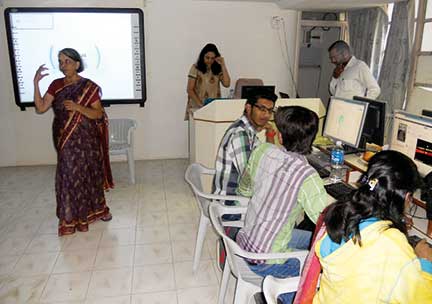Ranganayaki Srinivas
As civilizations evolve and each generation of learners and their circumstances change, it becomes inevitable for us to reconsider our beliefs on education in general and the roles and responsibilities of teachers and learners in particular. From the stone-age to the tech age, there have been many changes in the decisions related to what people thought was worth teaching, how they went about teaching it and what they felt was a measure of the achievement of educational goals. Teachers have always had the option to be progressive and futuristic or be “left behind”. Sometimes it is a conscious choice based on logic and reasoning and, at other times, the choice is automatically made given the lack of knowledge and skills and supported by fear and resistance. A precise understanding of the attitudinal changes required in the way we think about the teacher, the learner and education in general in the tech age, will surely help us keep pace with the changing world.
Teachers’ block
 In many schools, the infrastructure and facilities are frequently modified but what about the beliefs of the school? How often do principals and teachers reassess their teaching and learning methodologies? Some teachers feel they are too old to start or learn something new in their career, while others feel they are under pressure to cover the syllabus and cannot waste time getting familiar with new technology. There are also some teachers who start using technology enthusiastically but get frustrated keeping up with the hardware and software updates, and the pace at which the students seem to learn new technology.
In many schools, the infrastructure and facilities are frequently modified but what about the beliefs of the school? How often do principals and teachers reassess their teaching and learning methodologies? Some teachers feel they are too old to start or learn something new in their career, while others feel they are under pressure to cover the syllabus and cannot waste time getting familiar with new technology. There are also some teachers who start using technology enthusiastically but get frustrated keeping up with the hardware and software updates, and the pace at which the students seem to learn new technology.
Many teachers believe they will lose the students’ attention if they turn away from a teacher-centered class towards one using gadgets and technology. They also feel that students will lose respect for them if they are seen struggling with the technology that the students themselves are comfortable with.
“Today’s tech-savvy students are stuck in text-dominated schools” is the subtitle of a research compilation of students’ voices on technology by the organization ‘Education | Evolving’. The summary of the available research on student attitudes, perceptions, and behaviour reveal, “Many students say they use technology at “a fairly sophisticated level,” especially when compared with their teachers. Some students notice a digital divide, however, between students with high and low-levels of access to computers and the Internet.”
Support from students and technology
The tables have turned in this tech age. We can learn by teaching and we can also teach by learning. Education is no longer the passing of knowledge, skills, and habits from one generation to another but is a mutual interaction which benefits both the generations. While students today can teach their teachers and peers, and thus strengthen their own learning in the process, teachers could set an example by being open to change and by showing willingness to learn even as adults. The problems faced by teachers can easily be solved if we free ourselves from the shackles of age-old beliefs that have been proven wrong in the tech age. We will surely find a lot of support from students in this new effort. As Sylvia Martinez and Dennis Harper put it, “For help with technology integration and tech support, schools need look no further than their students.”
We have always believed that if the teacher wants to teach X to the students, she should know X+1 and only then can he or she teach effectively. In the tech age, it is possible for both the students and teacher to explore a topic together and share their findings. The student may be more tech savvy than the teacher while the teacher may know more about the subject and its application to help the students evaluate the information they find online. With websites like Youtube and free online courses like Coursera, teachers here have access to what teachers across the world do and a whole bank of readymade resources that need only a little modification to fit into the required context.
 Teachers are expected to motivate students, instill confidence in them and make the class learner-centric. If technology is used in the right manner, learners get automatically motivated; they gain confidence because they now feel comfortable in this space, and they can gain control of what they want to learn and how they want to learn it leading to both – teachers and students – taking ownership of the teaching-learning process. It has always been the responsibility of the teacher to bring in interesting materials to enable teaching. Technology, contrary to many teachers’ beliefs, is on the side of the teacher too! With the Internet, it is easy to take the topics studied in the classroom beyond the walls of the classroom and in a sense, bring the whole world into the classroom. There are many sites which offer a graded curriculum that can be implemented to complement the textbooks. There are also the CDs that are provided by textbook publishers that can be used to liven up the teaching in the classroom. With all the resources available at the click of a button, all that the teachers need to do is to provide support, appreciation, and perspective to ensure that the students are on track. In some schools, if the necessary infrastructure is not in place, teachers could just ask the students to watch the CD or research the topic online at home and come and share with the class what they saw, what they learned, and what they liked about the topic. “Flipping the classroom” would reverse the traditional teaching methodology and encourage higher-order thinking. Students would take more responsibility for their own learning while teachers could focus on facilitation. Even if 99 per cent of the students don’t do this, just listening to that one student talk about what he or she learned can motivate and inspire the whole class.
Teachers are expected to motivate students, instill confidence in them and make the class learner-centric. If technology is used in the right manner, learners get automatically motivated; they gain confidence because they now feel comfortable in this space, and they can gain control of what they want to learn and how they want to learn it leading to both – teachers and students – taking ownership of the teaching-learning process. It has always been the responsibility of the teacher to bring in interesting materials to enable teaching. Technology, contrary to many teachers’ beliefs, is on the side of the teacher too! With the Internet, it is easy to take the topics studied in the classroom beyond the walls of the classroom and in a sense, bring the whole world into the classroom. There are many sites which offer a graded curriculum that can be implemented to complement the textbooks. There are also the CDs that are provided by textbook publishers that can be used to liven up the teaching in the classroom. With all the resources available at the click of a button, all that the teachers need to do is to provide support, appreciation, and perspective to ensure that the students are on track. In some schools, if the necessary infrastructure is not in place, teachers could just ask the students to watch the CD or research the topic online at home and come and share with the class what they saw, what they learned, and what they liked about the topic. “Flipping the classroom” would reverse the traditional teaching methodology and encourage higher-order thinking. Students would take more responsibility for their own learning while teachers could focus on facilitation. Even if 99 per cent of the students don’t do this, just listening to that one student talk about what he or she learned can motivate and inspire the whole class.
In a way technology brings the students and teachers closer by helping them empathize with each other. Learning to use technology and becoming aware of your students’ interests, be it games, tv shows or websites can bridge the teacher-student divide. The students will enjoy lessons where references are made to topics and characters they know. The attitudinal change required does not demand a lot from the teachers as what they really need to do is to be more open to learning something new and become comfortable with learning from their own students and other “unconventional” sources. Teachers need to understand that this will not undermine their position as teachers. After all, who doesn’t respect someone who is honest about their fears and capabilities and is constantly trying to learn and grow?
________________________________________________________________________________
Google Resources
http://www.google.com/edu
https://www.google.com/edu/teachers/lesson-plan-search.html
http://googleblog.blogspot.in/2014/04/providing-more-cs-professional.html
YouTube Resources
https://www.youtube.com/schools
https://www.youtube.com/user/teachers
https://www.youtube.com/education
Blended Learning Resources
http://www.edu.gov.on.ca/elearning/blend.html
http://youtu.be/NWlJRjr3Rx0
http://www.edubuntu.org/screenshots
References
http://www.educationevolving.org/pdf/Tech-Savvy-Students.pdf
http://www.ascd.org/publications/educational_leadership/nov08/vol66/num03/Working_with_Tech-Savvy_Kids.aspx
The author is a teacher educator, materials producer, virtual teacher and webinar organizer. She has produced DVDs for teaching English to tribal children, Phonics Games for beginner learners and conducts webinars for teachers. She can be reached at <http://www.askrangoo.com> and google.com/+RanganayakiSrinivas.
